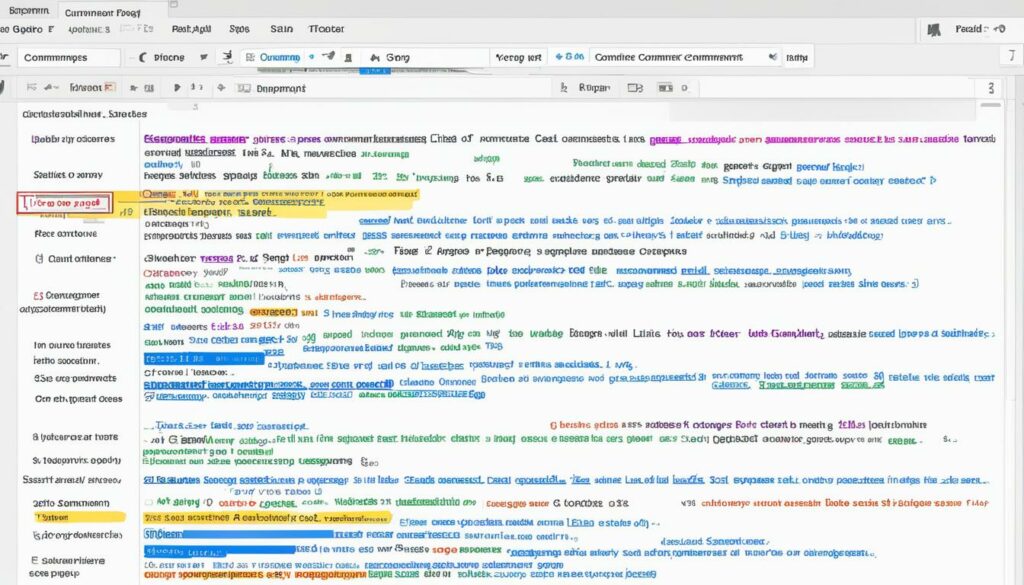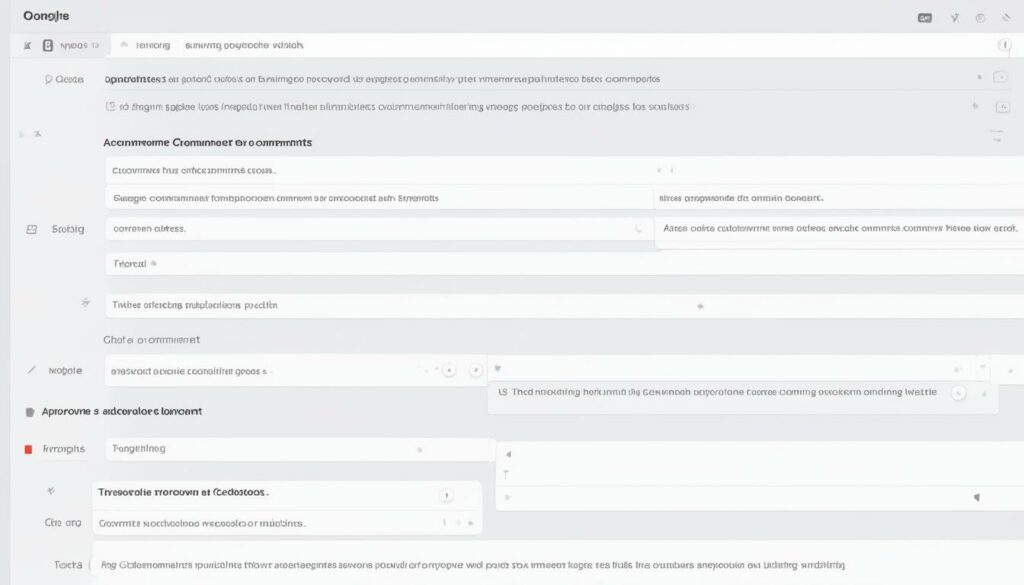Welcome to the world of WordPress comment moderation! As a website owner, one of the key aspects of cultivating a thriving online community is effectively managing and moderating comments. By fostering meaningful discussions and maintaining a safe environment, you can enhance user experience, encourage engagement, and ultimately grow your readership.
WordPress.com, which hosts millions of websites, witnesses a staggering 77 million new comments each month. With such high engagement, it’s crucial to implement robust comment moderation practices to ensure a positive user experience. Neglecting comment moderation can lead to a decline in readership and reputation.
In this guide, we will explore the best practices for WordPress comment moderation, including techniques to manage spam, create a comments policy, and utilize moderation tools and settings. By implementing these strategies, you can build an engaged community, foster productive discussions, and boost the overall success of your WordPress website.
Ready to dive in? Let’s get started!
Key Takeaways:
- Effective comment moderation is essential for fostering a positive user experience and community growth on WordPress.
- Ignoring comment moderation can result in a decline in readership and reputation.
- Implementing spam filtering, creating a comments policy, and utilizing moderation tools are crucial for successful comment moderation.
- Good comment moderation can lead to increased engagement, improved search engine optimization (SEO), and a trustworthy online reputation.
- BoostedHost provides excellent WordPress hosting for optimal website performance. Sign up through this link: www.boostedhost.com/wordpress-hosting.
What is Comment Spam?
Comment spam on WordPress refers to irrelevant or generic comments that contain poor grammar and may include suspicious links. Comment spam is different from spam emails and can be identified by its lack of specific references to the blog post and its generic nature. It is important to be able to recognize comment spam in order to effectively moderate comments on your WordPress site.
Comment spam can be a nuisance and detract from the authentic conversations happening on your WordPress site. It is crucial to have a solid understanding of what comment spam looks like so that you can take appropriate action. By identifying and addressing comment spam, you can maintain a clean and engaging comment section for your readers.
How to Identify Comment Spam
Here are some key characteristics to look out for when identifying comment spam:
- Poor grammar and spelling: Comment spam often contains grammatical errors, misspellings, and nonsensical sentences. These comments may be difficult to read and understand.
- Generic and irrelevant: Comment spam tends to be generic and unrelated to the specific blog post. It may include vague compliments, unrelated questions, or random statements.
- Links to suspicious websites: Comment spam sometimes includes links to websites that are low-quality, spammy, or potentially harmful. These links should be approached with caution.
- Multiple links and keywords: Comment spam often includes an excessive number of links or keywords in an attempt to manipulate search engine rankings.
- No personalization: Comment spam typically lacks personalization and doesn’t address the author or the content of the blog post directly.
By taking note of these indicators, you can quickly identify comment spam and take appropriate action to keep your WordPress comment section clean and free from spam.
Why Moderate WordPress Blog Comments
Comment moderation on WordPress blogs has significant benefits for your website and its community. By actively moderating the comments on your site, you can:
- Keep the conversation on topic and relevant to the blog post, ensuring a more meaningful and engaging discussion for all participants.
- Improve the user experience by filtering out spam comments. Comment spam can be both distracting and damaging to your site’s reputation.
- Protect against false or negative claims. By moderating comments, you can prevent the spread of misinformation or harmful content that may affect your credibility.
- Enhance your search engine optimization (SEO) efforts. Comment moderation allows you to avoid links to low-quality or malicious sites, which can positively impact your site’s ranking on search engine results pages.
By actively moderating comments on your WordPress blog, you can ensure that your site remains a relevant and trusted source of information and discussion in your niche.
“Comment moderation on WordPress blogs has several benefits. It helps keep the conversation on topic, improves the user experience by filtering out spam, protects against false or negative claims, and improves search engine optimization (SEO) by avoiding links to low-quality or malicious sites. Moderating comments ensures that your site is seen as relevant and trustworthy by search engines.”
If you want to optimize your WordPress site’s performance while ensuring effective comment moderation, we recommend WordPress Hosting from BoostedHost. Sign up now to access top-notch hosting services tailored to WordPress websites.
Create a Strategy for Your Comment Section
Before you start moderating comments on your WordPress site, it’s important to have a well-defined strategy in place for your comment section. A clear strategy will help ensure that you can effectively manage and engage with your audience, while also maintaining a positive and respectful environment. Here are some key elements to consider when creating your comment section strategy:
Determine Your Comment Approval Process
Decide whether you will pre-approve or post-approve comments on your site. Pre-approving comments gives you full control over what appears on your site, but it can also create delays in comment visibility. On the other hand, post-approving comments allows comments to go live immediately but requires proactive moderation to remove any inappropriate or spammy comments.
Create a Comments Policy
A comments policy outlines the guidelines for commenting on your site and helps set expectations for your audience. Clearly state what is acceptable and what is not, including rules regarding language, personal attacks, or self-promotion. Be sure to mention the consequences of violating these guidelines, such as comment removal or blocking users.
Encourage Meaningful Engagement
Actively encourage your readers to participate in meaningful discussions by asking open-ended questions or prompting them to share their thoughts and experiences related to your content. Engaging with your audience and responding to comments shows that you value their input, fostering a sense of community and encouraging further engagement.
Utilize Comment Moderation Tools
Take advantage of comment moderation tools available for WordPress to streamline the moderation process. Plugins like Akismet can automatically filter out spam comments, reducing the time and effort spent on manual moderation. Other plugins like WPBruiser can provide additional protection against comment spam and malicious activity.
Monitor and Moderate Regularly
Regularly monitor your comment section to ensure that all comments align with your comments policy. Respond promptly to comments, addressing any questions, concerns, or feedback from your audience. Be proactive in removing any inappropriate or spammy comments to maintain the quality of the conversation.
| Benefits of a Comment Section Strategy |
|---|
| 1. Efficient and streamlined comment moderation process |
| 2. Clear guidelines for your audience |
| 3. Increased engagement and meaningful discussions |
| 4. Protection against spam and inappropriate content |
| 5. Fostering a positive community atmosphere |
Creating a well-defined strategy for your comment section is crucial for effectively managing comments and creating a positive user experience. By implementing a clear comment approval process, having a comments policy, encouraging meaningful engagement, utilizing moderation tools, and regularly monitoring and moderating, you can foster an engaging and respectful environment for your audience.
The Initial Comments Moderation Setup
Now that you understand the importance of comment moderation, let’s dive into the initial setup. This involves utilizing various tools and settings to ensure smooth comment management on your WordPress site.
1. Akismet: The Ultimate Spam Fighter
One of the most powerful tools for comment moderation is Akismet. This plugin automatically filters out spam comments, saving you time and effort. Akismet uses advanced algorithms to identify and block spam, keeping your comment section clean and spam-free.
2. Manual Comment Moderation: Maintain Control
While Akismet takes care of spam, manual comment moderation gives you complete control over the comments that appear on your site. By manually reviewing each comment before approval, you can ensure that only relevant and valuable contributions are published.
3. Restrict Comments on Old Posts
As your site grows, managing the volume of comments can become challenging. One way to address this is by restricting comments on old posts. By limiting the comment feature on older content, you can focus your moderation efforts on newer and more active discussions.
4. Grow Your Following through Comments
Comments provide an excellent opportunity to engage with your audience and grow your following. By actively participating in discussions and responding to comments, you can foster a sense of community and encourage readers to return. This interaction not only strengthens your relationships with existing followers but also attracts new ones.
Implementing the initial comments moderation setup, including leveraging Akismet, implementing manual moderation, restricting comments on old posts, and actively engaging with your audience, lays the foundation for a well-managed and thriving comment section on your WordPress site.
What to Look for in Comment Spam
When moderating comments on your WordPress site, it is crucial to be able to identify and filter out comment spam. By recognizing the signs of comment spam, you can effectively maintain the quality and authenticity of your comment section.
Signs of Comment Spam
Here are some common signs that indicate a comment may be spam:
- Excessive links and keywords: Comments that contain an unusually high number of links or keywords are often spam. Such comments might be trying to manipulate search engine rankings or promote irrelevant websites.
- Suspicious or generic names: Commenters with suspicious or generic names, such as “OnlineCasino123” or “BestDealsNow,” are likely to be spam bots or individuals trying to promote their own websites.
- Generic messages: Comments that have generic content, which could apply to any blog post, are typically spam. Look out for comments like “Nice blog!” or “Great post, keep it up!” without any specific reference to the content of your blog.
- Offensive language: Comments that contain offensive or inappropriate language are clear indicators of spam. These comments often aim to provoke or offend readers and should be promptly deleted.
By being aware of these signs, you can efficiently filter out comment spam and maintain the integrity of your comment section.

| Signs of Comment Spam | Description |
|---|---|
| Excessive links and keywords | Comments containing numerous links and keywords that don’t relate to the blog post. |
| Suspicious or generic names | Commenters with names that seem automated or unrelated to the topic. |
| Generic messages | Comments that have generic content without referencing the specific blog post. |
| Offensive language | Comments containing inappropriate or offensive language. |
Basics of Moderating WordPress Comments
Moderating comments in WordPress is a vital aspect of managing your online community. By reviewing and taking action on individual comments, you can maintain a positive user experience and ensure a safe and engaging environment. To effectively moderate comments, it’s essential to understand the basic actions you can take.
Approving Comments
When a comment aligns with your community guidelines and adds value to the discussion, you can approve it. This allows the comment to appear publicly on your WordPress site, encouraging further engagement with your audience.
Replying to Comments
Engaging with your readers is an important part of building relationships and fostering a sense of community. By replying to comments, you show that you value their input and encourage further interaction.
Editing Comments
Editing comments can be helpful when minor adjustments are needed to improve clarity or address any potential violations of your guidelines. However, it’s crucial to strike a balance between preserving the author’s voice and maintaining the integrity of your platform.
Marking Comments as Spam
Identifying and flagging spam comments is an essential step in maintaining the quality of your comment section. Spam comments often contain irrelevant or promotional content and can detract from the overall user experience. Marking such comments as spam helps filter them out and keeps your community focused on meaningful discussions.
Deleting Comments
In some cases, you may need to delete comments that violate your guidelines or contain offensive content. Deleting comments should be done sparingly and as a last resort, ensuring that it aligns with your moderation policy.
By leveraging these basic comment moderation actions, you can effectively manage the discussion on your WordPress site and create a welcoming environment for your community. Remember, finding the right balance between encouraging engagement and maintaining the quality of the comments is crucial for a positive user experience.

We recommend WordPress Hosting from BoostedHost for optimal performance. Sign up now through this link: www.boostedhost.com/wordpress-hosting
How to Configure the WordPress Comment Settings
Configuring the WordPress comment settings allows you to have better control over the comments on your site. By customizing these settings, you can create a more organized and engaging comment section. Here are some options to consider:
Enable Comment Notifications
By enabling comment notifications, you will receive an email notification whenever someone leaves a comment on your WordPress site. This allows you to stay updated and respond promptly to user engagement.
Require Name and Email
To ensure authenticity and discourage spam comments, you can require users to provide their name and email before submitting a comment. This helps in maintaining a genuine and trustworthy commenting environment.
Enable Threaded Comments
Threaded comments allow users to reply directly to specific comments, creating a more interactive and organized discussion. This helps in fostering engaging conversations and encourages users to come back and participate further.
Break Comments into Pages
If you receive a high volume of comments, breaking them into pages can make navigation easier for your readers. This prevents excessively long comment sections and improves the overall user experience.
Choose Display Order of Comments
You have the option to choose the display order of comments on your WordPress site. You can set them to display in chronological order (oldest to newest) or reverse chronological order (newest to oldest), depending on your preference.
Configuring these WordPress comment settings helps in managing and organizing comments effectively. Take advantage of these options to create a seamless and engaging user experience on your site.
| Option | Description |
|---|---|
| Enable Comment Notifications | Receive email notifications when new comments are posted. |
| Require Name and Email | Mandate users to provide their name and email for comment submission. |
| Enable Threaded Comments | Allow users to reply directly to specific comments, facilitating interactive conversations. |
| Break Comments into Pages | Divide comment sections into multiple pages for easier navigation. |
| Choose Display Order of Comments | Select the order in which comments are displayed (chronological or reverse chronological). |

Configure your WordPress comment settings to optimize user engagement and create a vibrant commenting community on your site.
How to Moderate Comments Using Plugins
Comment moderation is an essential aspect of managing your WordPress site’s comment section. To enhance your ability to effectively moderate comments, you can rely on various WordPress comment moderation plugins. These plugins provide advanced features, real-time comment syncing, and social media integration to improve the overall commenting experience.
Jetpack Comments
Jetpack Comments is a popular plugin that streamlines comment moderation on your WordPress site. It offers features like real-time notifications, comment threading, and advanced spam filtering. With Jetpack Comments, you can efficiently manage and respond to comments, fostering engaging conversations within your community.
Disqus
Disqus is another widely used comment moderation plugin. It allows for seamless integration with your WordPress site, providing tools to moderate comments, manage user profiles, and customize the comment section’s appearance. Disqus also offers social sharing options, encouraging visitors to share your content and generate more engagement.
Livefyre
Livefyre is a robust comment moderation plugin that emphasizes real-time user engagement and social integration. It offers features such as comment syncing, social login options, and content curation capabilities. With Livefyre, you can easily curate and display user-generated content from various social platforms, enhancing community interaction and expanding your website’s reach.
By utilizing these comment moderation plugins, you can take full control of your comment section, streamline the moderation process, and provide a seamless and engaging experience for both your users and site owners.
Best Practices for WordPress Comment Moderation
Implementing best practices for WordPress comment moderation is crucial to maintaining a positive comment section and fostering a welcoming environment for users. By following these effective strategies, you can ensure that your comment section remains engaging and free from spam.
Enable Comment Moderation
First and foremost, it’s essential to enable comment moderation on your WordPress site. This allows you to review and approve comments before they are published, ensuring that only appropriate and relevant content appears on your website.
Utilize Anti-Spam Plugins
Utilizing anti-spam plugins, such as Akismet, is highly recommended. These plugins automatically filter out spam comments, saving you time and effort in manually moderating each comment.
Implement CAPTCHA or reCAPTCHA
To further prevent spam comments, consider implementing CAPTCHA or reCAPTCHA. These tools add an extra layer of security by requiring users to complete a simple verification process, reducing the likelihood of automated spam comments.
Encourage Genuine Engagement
Creating an environment that encourages genuine engagement is key to maintaining a positive comment section. Respond to comments, ask questions, and actively participate in discussions with your readers to foster meaningful interactions.
Set Clear Guidelines
Setting clear guidelines for commenting on your website helps maintain a respectful and productive comment section. Clearly state your expectations regarding language, behavior, and topic relevance to guide users in contributing valuable comments.
Use Comment Moderation Plugins
Consider using comment moderation plugins, such as Jetpack Comments or Disqus, to enhance your moderation capabilities. These plugins offer advanced features, real-time syncing, and social media integration, providing more control and improving the overall commenting experience.
Monitor and Respond Regularly
Regularly monitoring your comment section and promptly responding to comments shows that you value your readers’ input and actively engage with them. Be attentive to new comments and continue the conversation to build a strong sense of community.
Clean Up Spam
Regularly clean up spam comments to maintain a clutter-free comment section. Delete or mark as spam any comments that violate your guidelines or contain irrelevant content, ensuring that your comment section remains focused and relevant.
| Best Practices | Benefits |
|---|---|
| Enable Comment Moderation | Prevents inappropriate or spam comments from appearing |
| Utilize Anti-Spam Plugins | Saves time by automatically filtering out spam comments |
| Implement CAPTCHA or reCAPTCHA | Reduces the likelihood of automated spam comments |
| Encourage Genuine Engagement | Fosters meaningful interactions and enhances user experience |
| Set Clear Guidelines | Maintains a respectful and productive comment section |
| Use Comment Moderation Plugins | Enhances moderation capabilities and improves the commenting experience |
| Monitor and Respond Regularly | Builds a strong sense of community and shows reader engagement |
| Clean Up Spam | Maintains a clutter-free and relevant comment section |
Conclusion
Effective WordPress comment moderation is essential for fostering community engagement and ensuring a positive user experience. By implementing best practices and utilizing moderation tools and settings, you can create a welcoming environment that encourages meaningful discussions and builds a sense of community.
Comment moderation plays a crucial role in maintaining the credibility and trustworthiness of your website. By filtering out spam comments and irrelevant content, you can keep the conversation on topic and protect against false or negative claims. Additionally, effective comment moderation improves search engine optimization (SEO) by avoiding links to low-quality or malicious sites.
By prioritizing comment moderation, you can reap the benefits of a well-moderated comment section. It allows you to interact with your audience, gain valuable insights, and build a loyal following. Responding to comments, setting clear guidelines, and using comment moderation plugins are some of the best practices that contribute to effective comment moderation.
FAQ
Q: What is Comment Spam?
A: Comment spam on WordPress refers to irrelevant or generic comments that contain poor grammar and may include suspicious links. It is important to be able to recognize comment spam in order to effectively moderate comments on your WordPress site.
Q: Why Moderate WordPress Blog Comments?
A: Moderating WordPress blog comments has several benefits. It helps keep the conversation on topic, improves the user experience by filtering out spam, protects against false or negative claims, and improves search engine optimization (SEO) by avoiding links to low-quality or malicious sites.
Q: How Do I Create a Strategy for My Comment Section?
A: Before starting to moderate comments, create a strategy for your comment section. Decide whether you will approve or reject comments before they go live, considering the advantages and disadvantages of pre-approving comments. Additionally, create a comments policy that outlines the guidelines for commenting on your site and the consequences for violating those guidelines.
Q: What is Involved in the Initial Comments Moderation Setup?
A: The initial comments moderation setup involves using tools like Akismet, a plugin that automatically filters out spam comments. Adjusting comment settings allows you to enable or disable comments, disable comments for specific pages or posts, and limit comments to registered users. Restricting comments on old posts can help manage the volume of comments, and actively engaging and responding to comments can help grow your following.
Q: What Should I Look for in Comment Spam?
A: Signs of comment spam include comments that contain a bunch of links, keywords, and strange characters; suspicious or generic names; generic messages that could apply to any blog; and offensive language. Knowing what to look for can help effectively filter out spam comments.
Q: What are the Basics of Moderating WordPress Comments?
A: Moderating WordPress comments involves reviewing and taking action on individual comments. Actions include approving, replying, editing, marking as spam, or deleting comments. Understanding these basic actions helps in effectively managing comments and maintaining a positive user experience.
Q: How Do I Configure the WordPress Comment Settings?
A: WordPress comment settings allow you to control and filter comments. Options include enabling comment notifications, requiring users to fill out their name and email, enabling threaded comments, breaking comments into pages, and choosing the display order of comments. Configuring these settings helps in managing and organizing comments on your WordPress site.
Q: How Do I Moderate Comments Using Plugins?
A: Using comment moderation plugins can enhance your ability to manage comments on your WordPress site. Plugins like Jetpack Comments, Disqus, and Livefyre offer advanced moderation features, real-time comment syncing, and social media integration. These plugins provide more control over the moderation process and improve the commenting experience for both users and site owners.
Q: What are the Best Practices for WordPress Comment Moderation?
A: Implementing best practices for WordPress comment moderation helps create a welcoming and safe space for users. Enabling comment moderation, utilizing anti-spam plugins, implementing CAPTCHA or reCAPTCHA, encouraging genuine engagement, setting clear guidelines, using comment moderation plugins, monitoring and responding regularly, and cleaning up spam are some of the best practices for effective comment moderation.
Q: What is the Importance of WordPress Comment Moderation?
A: Effectively moderating comments on your WordPress site is crucial for community engagement and positive user experience. By implementing best practices and utilizing moderation tools and settings, you can create a welcoming environment for meaningful discussions and foster a sense of community. Prioritizing comment moderation contributes to the credibility and trustworthiness of your website.












